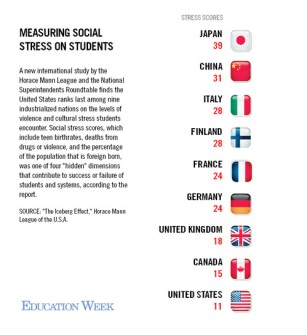What do international comparisons really tell us about how American education can improve?
A new report, “The Iceberg Effect,” by the Horace Mann League of the U.S.A and the National Superintendents Roundtable aims to put student achievement and long-term education outcomes within the broader social and economic context of different countries.
“Many of these international comparisons are comparing us with inappropriate countries—tiny principalities, religious monarchies—and we wanted to create more appropriate comparisons,” said James Harvey, the executive director at the National Superintendents Roundtable.
The researchers winnowed data from the last five years in 40 international data systems in nine industrialized countries considered to be more similar to the United States. The group then compared the countries on 24 indicators in six areas, with a total of 40 points available in each area.
Two of these, student outcomes (such as international reading scores and secondary school completion) and system outcomes, such as the average years of education for adults, are what Harvey considers the “tip of the iceberg.”
“When we cherry-pick one piece of information, like PISA scores, we are acting as though that’s the only thing that counts,” Harvey said. “We wanted to get a discussion started about the fact that for 30 years we’ve been fiddling around with the tip of the iceberg and done nothing at all to address all this that’s going on below the water line.”
The Invisible ‘Iceberg’
What’s going on below the surface? The report authors identified four dimensions that may contribute to students’ health and educational growth:
- Economic equity, including income inequality, child poverty, infant-mortality rates, and economic mobility across generations;
- Social stress, including rates of violent and drug-related deaths overall, births to parents who are ages 15 to 19, and the percentage of each country’s population that is foreign born;
- Family supports, including access to preschool, child-death rates as a result of abuse or neglect, and family benefits both as total spending on families with two children and as a percentage of a nation’s gross domestic product; and
- School supports, including total spending and spending as a percentage of each nation’s GDP, average class size, and teacher workload.
For example, as the chart below shows, United States students faced the worst social stresses of any of the counties (unlike other indicators in areas like equity, having low scores here represents higher stress levels):

With this data alone, it’s hard to tell how different aspects of social and economic policy actually affect student outcomes, either in the short or long term. The United States, for example, has the best long-term system outcomes of any country, with the most-educated adults and a significant share of the world’s high achievers in science on the Program for International Student Assessment. But it has middling short-term student outcomes and provides nearly the lowest level of support for families, even in the face of high levels of economic inequality and social stress.
And then there’s the much-talked-about Finland, which shows above-average results across the board in supports, equity and student outcomes, but ranks below the United States, Canada, and the United Kingdom in long-term education outcomes.
Charles Fowler, the executive director of the New Hampshire-based Suburban School Superintendents and the president-elect of the Horace Mann League, said the report needs follow-up study to start figuring out how different parts of a student’s environment affect each other.
“Our hope is by putting these findings out in front of people, anomalous as some may be, it will stimulate research to get at some of these strange results,” Fowler said. “You can have all the resources in the world, but if you cannot bring to bear the kind of social and health resources needed to improve the mental and economic well-being of children and families, you are not going to make much progress.”
Researchers will discuss the report’s findings later today at a symposium in Washington, and you can see more in the video below.



